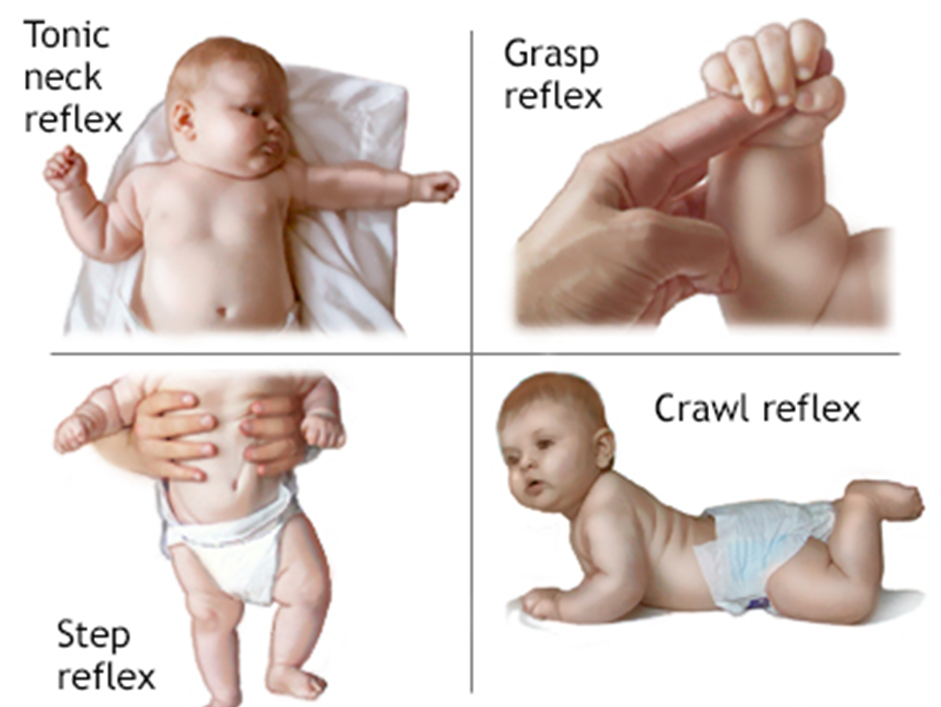During a well-baby check, the nurse recognizes the presence of what as indicative of appropriate neurological development?
Appropriate weight
Vernix caseosa
Presence of lanugo
Expected reflexes
The Correct Answer is D
Choice A reason: This is not an indicator of appropriate neurological development. Appropriate weight is a measure of the physical growth and nutritional status of the baby. It is influenced by the baby's genetics, gestational age, birth weight, feeding habits, and health conditions. Appropriate weight does not reflect the baby's brain development or function.
Choice B reason: This is not an indicator of appropriate neurological development. Vernix caseosa is a white, cheesy substance that covers the skin of the baby in the womb. It protects the skin from the amniotic fluid and helps with temperature regulation and infection prevention. Vernix caseosa is mostly shed before or during birth, and does not relate to the baby's brain development or function.
Choice C reason: This is not an indicator of appropriate neurological development. Presence of lanugo is a fine, soft hair that covers the body of the baby in the womb. It helps to keep the baby warm and hold the vernix caseosa on the skin. Presence of lanugo is usually lost before or shortly after birth, and does not indicate the baby's brain development or function.
Choice D reason: This is the best answer. Expected reflexes are involuntary movements or responses that the baby makes in reaction to certain stimuli. They are controlled by the nervous system and indicate the baby's brain development and function. Expected reflexes include the rooting, sucking, grasping, Moro, and Babinski reflexes. The nurse should assess the presence, strength, and symmetry of these reflexes during the well-baby check.

Nursing Test Bank
Naxlex Comprehensive Predictor Exams
Related Questions
Correct Answer is D
Explanation
Choice A reason: This is not a statement that indicates an issue with self-concept. The client acknowledges their difficulty with the colostomy appliance, but also shows that they have family support and assistance. This suggests that the client has a positive self-concept and coping skills.
Choice B reason: This is not a statement that indicates an issue with self-concept. The client expresses their willingness to communicate with their relative who has a colostomy. This indicates that the client has a positive self-concept and social support.
Choice C reason: This is not a statement that indicates an issue with self-concept. The client recognizes that learning to manage the colostomy may take some time and practice. This implies that the client has a positive self-concept and realistic expectations.
Choice D reason: This is the statement that indicates an issue with self-concept. The client expresses a negative and hopeless attitude towards the colostomy. This suggests that the client has a poor self-concept and low self-efficacy.
Correct Answer is D
Explanation
Choice A reason: This is not a statement that indicates a distorted body image. The client may have a high or unrealistic expectation of their functional ability, but it does not mean that they have a negative or inaccurate perception of their appearance.
Choice B reason: This is not a statement that indicates a distorted body image. The client may be experiencing grief or depression, but it does not mean that they have a low or distorted self-esteem.
Choice C reason: This is not a statement that indicates a distorted body image. The client may be feeling anger or resentment, but it does not mean that they have a poor or distorted self-image.
Choice D reason: This is the statement that indicates a distorted body image. The client shows a sign of avoidance or denial of their amputated limb. This implies that the client has a distorted body image and a negative self-concept.
Whether you are a student looking to ace your exams or a practicing nurse seeking to enhance your expertise , our nursing education contents will empower you with the confidence and competence to make a difference in the lives of patients and become a respected leader in the healthcare field.
Visit Naxlex, invest in your future and unlock endless possibilities with our unparalleled nursing education contents today
Report Wrong Answer on the Current Question
Do you disagree with the answer? If yes, what is your expected answer? Explain.
Kindly be descriptive with the issue you are facing.
